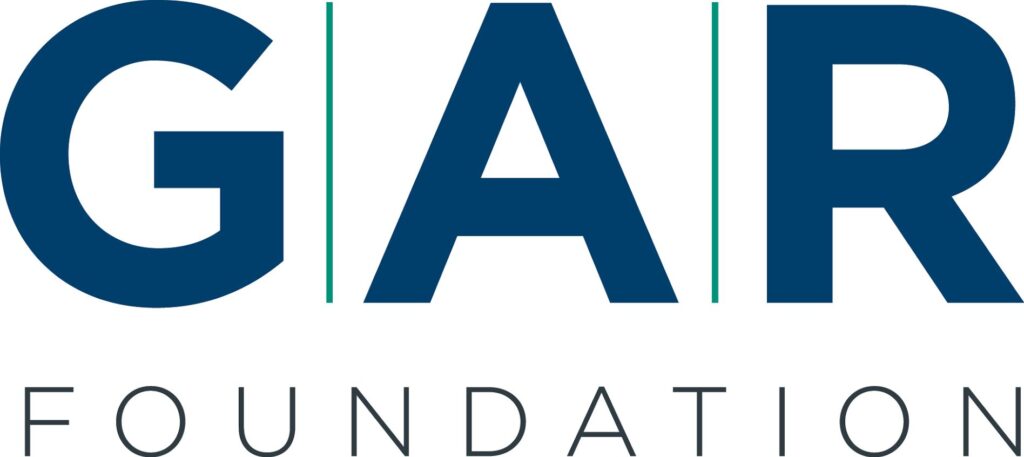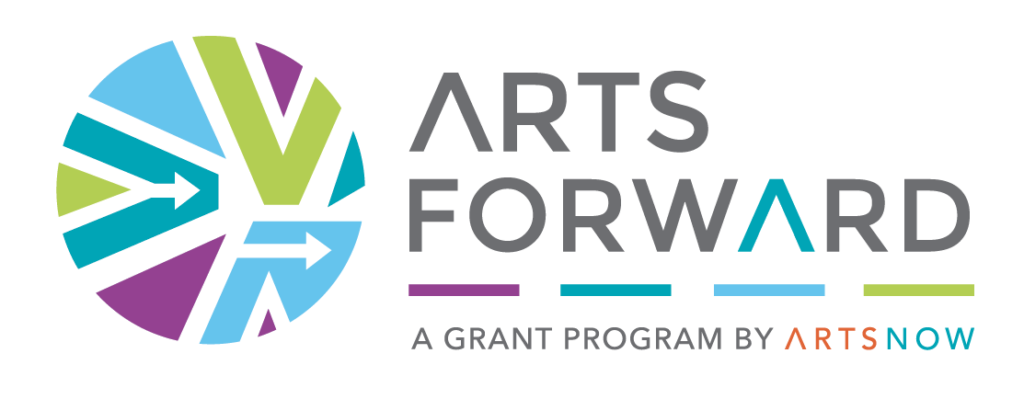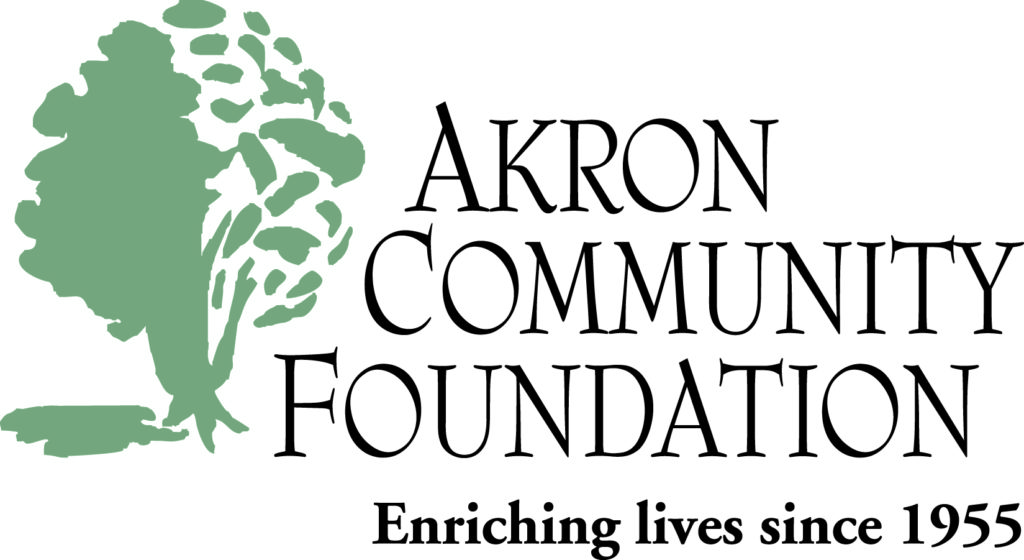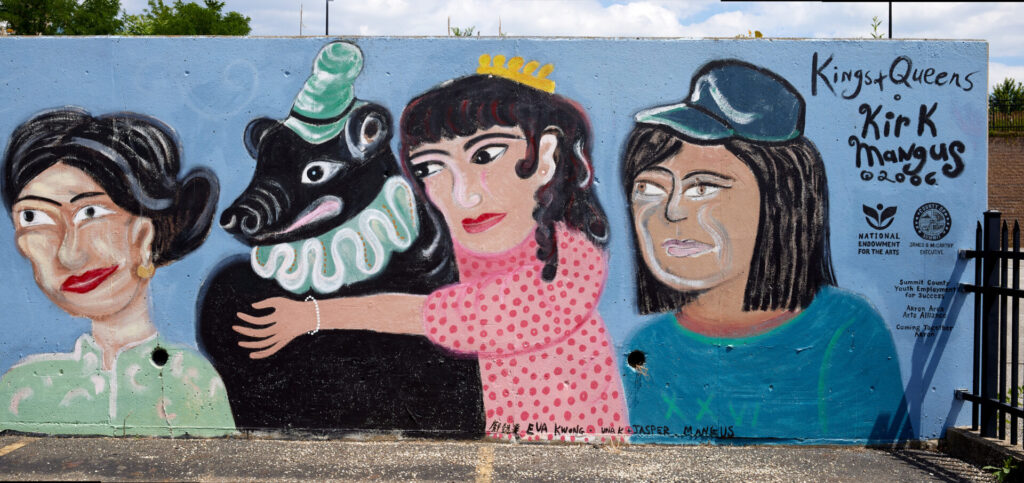
Kirk Mangus grew up in an artistic household in Sharon, Pennsylvania. Both his mother and father were high school art teachers, providing Mangus with a creative environment to explore as a child. He experimented with paper, pencils, watercolors, and clay, and read his parents’ art history books in his spare time. Mangus’ parents also exposed him to museums, art shows, and studios at an early age.
When Mangus went to college in the early 1970s, his career path wasn’t a tough choice. Art was his life—it was what his parents encouraged, and it was something he was truly interested in. Mangus attended the Rhode Island School of Design where he ended up studying ceramics. There he met his future wife, Eva Kwong, who is also a ceramic artist. During these years and beyond Mangus worked in pen and ink, then painting, wood carving, and pottery. He’s even made jewelry and large Styrofoam sculptures; really, Mangus worked in whatever materials he had access to.
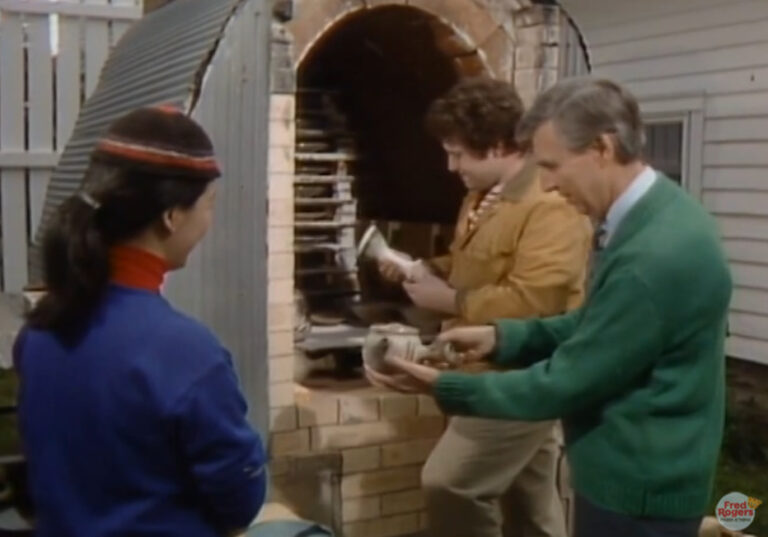
As he grew into his career as an artist, Mangus drew inspiration from a variety of influences. His childhood experiences provided a strong base of inspiration. Young Mangus collected components of his style from reading: comics, illustrated children’s books, and art history books about Greek and Roman art. College aged-Mangus benefitted from the great art history department at the Rhode Island School of Design who taught him about a broad spectrum of artwork and cultures. Other specific art movements and artists that interested Kirk included Art Brut, Jean Dubuffet, Pablo Picasso, color field painters, abstract expressionists, the German expressionists, Mayan artwork, Japanese prints, as well as traditional Chinese, Korean, and Japanese ink paintings.
Another major factor that influenced Mangus’ art practice was his taking an Earth, Air, Fire, Water workshop in Grass Valley, California. From that point on he became interested in wood firing, which became a large part of his oeuvre. Kwong recounts that when she joined him during one of these workshops, they learned to dig local clay and how to process those natural materials to make clay and glazes. They also learned how to build and use kilns themselves, a skill which they took back to Pennsylvania to build their own wood kiln. For the rest of their lives together, Mangus and Kwong would stop and dig up natural clay wherever they travelled.
From these multicultural and multimedium factors, Mangus formed his own art style, which departed from traditional forms of aestheticism and beauty. His style evolved from pencil drawings, to paintings, to pottery, and then to painting on his pottery. In the paintings on his pots, Mangus drew from imagery on Greek and Mayan pottery. His relationship with clay, profoundly influenced by the Earth, Air, Fire, Water Workshop, was integral to his work. He felt that each clay had its own characteristics and that, much like wine, it reflects the geological history of an area. The different colors, grain size, firing capabilities, etc. contribute to the diversity of clay, and therefore, to the diversity of his pottery.
Mangus’ work grew in acclaim in 1982 when he was honored with an individual artist fellowship from the National Endowment for the Arts. A couple of years later, in the fall of 1985, Mangus started teaching at Kent State University. There, he worked amongst a community of loving students until his death in 2013. During his period at Kent, Mangus worked on a variety of large-scale projects in the community. In 1995, he designed a poster and painted a wall for a show called “Radical Ink” at Spaces in Cleveland. This led to another project in which Mangus and several other artists painted a mural on the wall at the Southbend Regional Art Museum in Indiana. In 2005, Mangus was invited to be in a “Master Drawings” exhibition at the Akron Art Museum. The show ended up being presented at Summit Artspace, which also asked him to paint a mural inside their space.
All of this build-up of larger projects led Summit Artspace to commission Mangus again to paint an even larger mural, this time on the 225-foot wall in their parking lot. Several grants contributed funds to the mural, including the lead grant, “Challenge America: Reaching Every Community” from the National Endowment for the Arts. Mangus had total freedom to decide the subject matter and title for the mural. As Kwong describes it, Mangus thought of the wall like a Chinese ink painting scroll, one which evolved from one side to the other. He knew he wanted to include an aspect of cultural background and identity in the piece. The final influence for his massive mural project was that he was asked to work with local students. As a result, the final idea arose: Kings and Queens, portraits of people, mostly people Mangus knew, which represented how we are rulers of our own destinies.
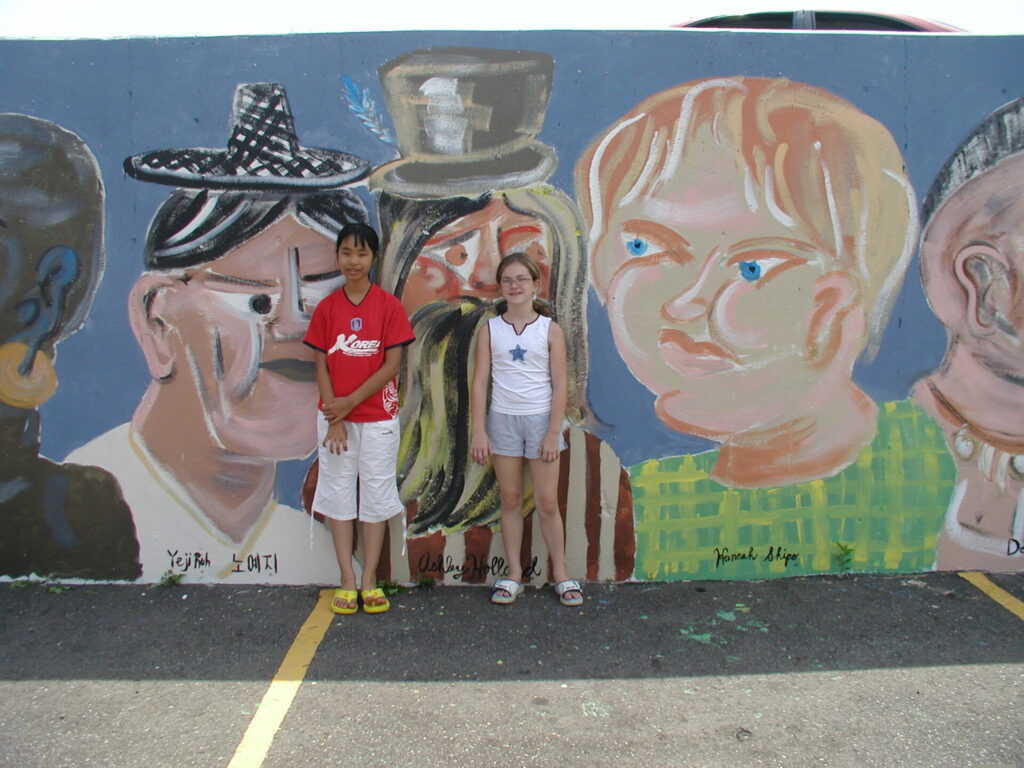
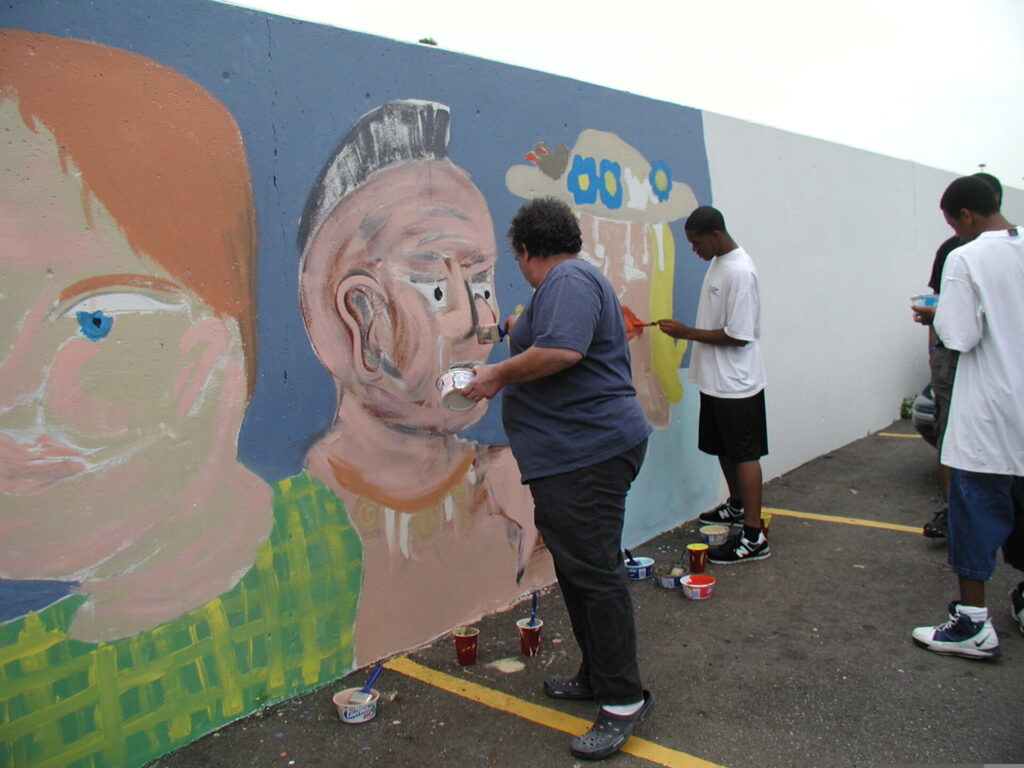
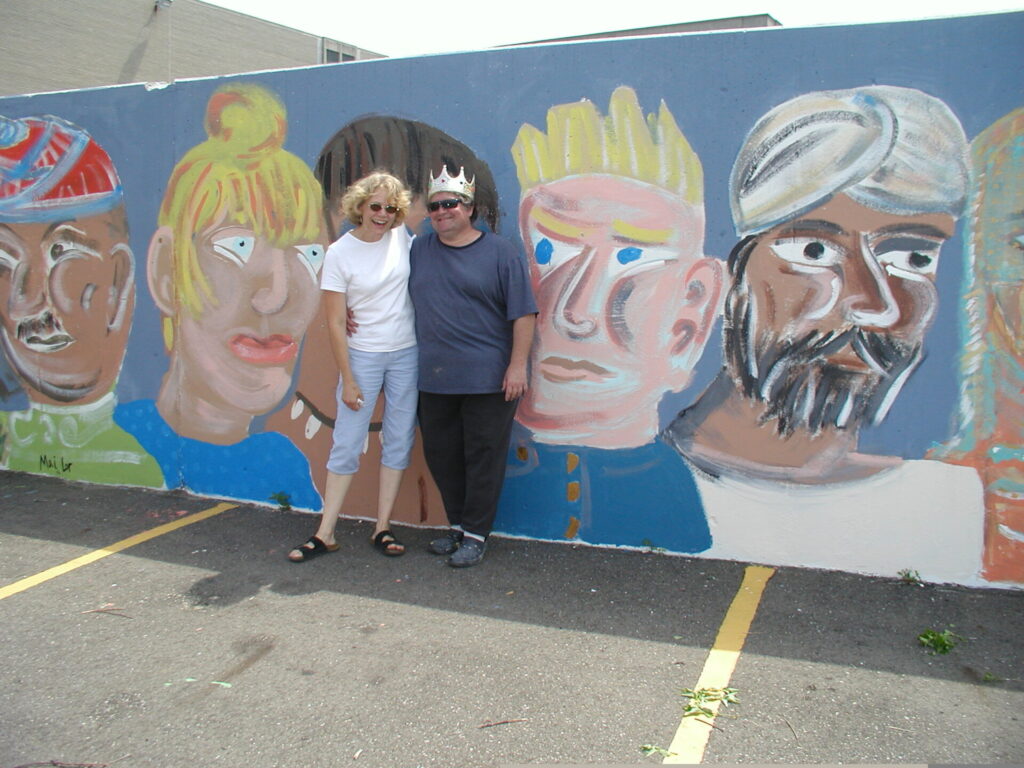
Mangus created the mural portraits in a unique way. He loved observing and drawing people, but not from photographs. Mangus worked from memory, which resulted in vibrant characterizations of his friends, family, students, and famous people. While painting the mural, Mangus was conscious that it needed to be graphic enough to be comprehensible from the road, yet detailed enough to still be interesting from close up. Akron students helped in his painting process, mixing colors and filling in larger areas. At the end of the project, Mangus invited the students and community members he had painted to come and sign the wall, to claim their individuality and heritage.
As a finished product, Mangus’ Kings and Queens mural documents the community in Akron that is formed by of all the cultures Akronites bring to the area. It honors the past, present, and future of cultural heritage. The subjects’ clothing links them to the culture of their family’s past, while each individual’s face represents the present, and the future is a hope that the portrait subjects will bring their children and grandchildren to see it. Kings and Queens ultimately preserves the cultural heritage of the Akron community.
Seventeen years later, in 2022, Mangus’ mural had faded. Kwong, who knew Mangus and his style better than anyone, headed a restoration effort to brighten and revitalize her late husband’s work. She hopes that people will look upon the refinished mural and connect to it for years to come. In connection with Kwong’s restoration project, Summit Artspace commissioned six local artists to paint a community member for a small exhibition. Titled Faces of Akron, the exhibition built upon Mangus’ idea of representing community members and cultural heritage by including a whole new group of people in the project. After the mural refinishing and the related Faces of Akron exhibit, Kwong hopes to take the Faces of Akron project into the future with more murals on city walls or other shows in the Akron area, all to honor Mangus’ work and vision.
An Interview with Eva Kwong
Well hi, I’m Eva Kwong. I’m an artist. I live here in Ohio and I am the wife to the late Kirk Mangus. We met as undergraduates in the same freshman class at Rhode Island School of Design in, I think, 1971.
Yes, he grew up in Sharon Pennsylvania. His parents were both artists. His mother was actually his high school art teacher and taught at Sharon High School. His father taught at the Hickory High School. Both taught for over 30 years. So Kirk grew up in an artistic household. He was an only child. They always involved him in art projects. He said, they were always available. That he had clay on the kitchen counter that his father would bring home from school, and he could make anything he wanted. Which I think when he was little he would make animals and battle scenes because he was so interested in Greek and Roman culture. He always had paper, pencil, pens, and watercolors. His mother did a lot of watercolors, so she taught him how to do watercolors. So all that was always available. They had lots of art books that he read cover to cover many times. They took him to see art shows and museums. And, both his parents took classes at the Cleveland Institute of Art, so they would bring him along to go visit the studios to see what people are doing there. In the 1970s, when he was a teenager, his parents would take classes at Penland School of Craft in North Carolina. And because he was an only child, they couldn’t leave him at home, so they would sign him up for a class, or actually at that time he was too young to officially qualify to be in the class, so they would take him along. And get him a job on campus like washing toilets or cleaning big pots in the kitchen. Helping clean the dormitory, and be a gopher on campus, picking teachers up at the airport and driving everybody around. So that was his early introduction to in many ways, sort of, the art world. He met a lot of artists because he was driving them back and forth from the airport so he got to talk to them. So he met a lot of people during that time.
Well, I don’t think he had a choice. (Laughs.) I think his parents just expected him to be. I think he was always interested because he had always made projects. You know, as far as he could remember, he was drawing or he was making things out of clay. His parents, of course, also encouraged him. I don’t think he thought about doing too many other things.
Well yes, many things. Being an only child, he read a lot. That’s also why he had lots of free time to do lots of drawings all the time. And his parents had lots of art books, you know. I think experience is cumulative, so, through his reading and interest in Greek and Roman culture when he was in elementary school, for example, that he of course looked up all the Greek pottery, all the frescoes, all the wall paintings, you know, and in conjunction with his readings on the writers and poets of those times, and of course later on in life it led to other cultures that he was interested in. It also led to a study of art history. He was interested in comics because that was something he could walk a couple blocks to the street corner and buy when he was a kid. He talked about the illustrators of children’s books that he read. He was interested in a lot of the folk art. We had a great art history department at the Rhode Island School of Design so we were introduced to broad range from prehistoric to contemporary work. So that gave us a really great foundation to a broad spectrum of artwork and cultures. Some other things he was also very interested in: Art Brut, Dubuffet, Picasso, color field painters, abstract expressionists, the German expressionists, a lot of the Mayan artwork, and a lot of Japanese prints. Traditional Chinese, Korean, and Japanese ink paintings. He was a voracious reader and also used to read to his classes while they would throw on the wheel.
Well, through his life, his decades of art-making evolved his style. I don’t think people usually decide on a style before they start. That evolves over the years, as you work. He started out doing very precise pencil drawings. And that he would build up all these little marks and that’s from looking at Renaissance drawings and Rembrandt drawings and Goya drawings. And then he started putting images on his pottery, so he started painting. So it went from pencil to a brush. That led to a study of ink paintings and brush paintings, and images on pottery. Historic images on pottery, from the Greek pots to the Mayan pots, and that led to other kinds of world artwork.
He would work in just about anything, you know, from pencil drawing to ink. Pen and ink initially, then brush and ink. Watercolors, oil painting, acrylic. He did a lot of wood carvings for a while because there were a lot of logs on his parents’ property that he wanted to use up. He’s worked in metal, he’s made jewelry, he’s made large styrofoam sculptures. So he’s worked in a variety of material…usually whatever he could get his hands on.
Well, he became interested in wood firing in the mid-1970s. He took an earth, air, fire, and water workshop in Grassvalley, California. He was there for three summers working with them. And, he also became one of the assistants there. I spent one summer there. We learned to dig clay from nearby, and we learned to process the natural materials both for the clay and for glazes. We learned to get wood from the nearby mountains and make bricks and build kilns and fire them. Then, in 1980, we moved back to Pennsylvania and built our own wood kiln. And because we were in the country, it was in many ways easier to make our own bricks than to buy bricks and try to have them delivered to our little hill or big hill. So we made all the bricks for our kiln and we also went around and dug clay to make both for our kiln and as well the artwork we make to put in the kiln. Both pottery and sculpture. And that continued to be a lifelong influence on him, a lifelong interest. He always went around whenever we traveled, whenever we drove across country. We would stop in places where we thought there might be clay. Dig it up and put it in the back of the car or back of the truck and bring it home and experiment with it. And he continued the whole time he was teaching here in Kent, Ohio.
Well, he loved teaching here. He started here in the fall of 1985 and stayed until he died suddenly of a brain aneurysm in 2013. He loved the community of his students. You know, it was really quite wonderful because in the ceramics lab, we had our own building. So, in many ways, we had our own world in there, within that building. He would oftentimes involve some of students to go with him, to go dig clay. Or they would find clay and bring it in to show him to experiment with.
Kirk was interested in using clay from the local areas where he lives. When we lived in Pennsylvania, we drove around and dug up clay there. When we moved to Ohio, we started looking at all the clay in the Ohio area. He felt that each clay has its own characteristics and that because of the composition of the clay, much like wine, it reflects the geological history of the area. It has different colors, different kind of grain size, and it fires differently. It behaves and even handles differently. Some clays are more plastic, some clays are less so, some clays are more sandy. You also have unique colors that are possible, so in a world where most people use clays that are commercially prepared, where it is identical, it’s homogeneous, no matter where you bought it, in New York or California, it has the same look. But with natural clays, each one is different and unique, and he liked that diversity of surfaces and colors.
I only know a little bit, it was another NEA-sponsored project for community projects. He worked with the middle school students there, and I think they did portraits of themselves. I have to look up the year, if it was before or after the Akron mural. We can talk about other murals he’s done, which I’m sure at the time led up to it.
Well, he’s always done drawings. He often had shows of them. He used to make new drawings for a new poster or postcard whenever he has a show somewhere, so he would give them away. In 1995, there was a show called “Radical Ink” at Spaces in Cleveland, so he designed the poster for them and he was also invited to do a wall for them. So he painted directly black paint on the white wall for the show. And then that led to another. In 1998, he was invited by William Tourtillotte to participate in a show called “Tales of Anxiety, Prophecy, and Reclamation,” and I think he invited several artists to paint directly on the wall at the museum – and this is at the Southbend Regional Art Museum in Southbend, Indiana. So, Kirk was there for a whole week and I think it’s maybe 100 foot – I’m not exactly sure – and maybe 15-foot high ceilings that he painted directly with black paint on the wall, and so that was his largest painting drawing at that time. This was in 1998, and it was a really fabulous show and it was a really fabulous drawing. So, unfortunately, they didn’t really think about it because it was a temporary show, so they had to basically erase it – paint over it – for the next event. He has traveled, he’s been to Korea several times and he’s been to Japan several times. Also, in 2001, he was in Panevezys, Lithuania, for their International Ceramics Symposium; he did large drawings there that he exhibited at the city hall, so he’s done several. And then in 2005, he was invited to be in the new “Master Drawings,” organized by the Akron Art Museum in Akron. And because the Museum was doing a renovation at that time, the show was presented at Summit Artspace, and they asked him in addition to those ink paintings and watercolors to also do a wall – and that is the wall titled “Some Kind of Fashion” that he painted directly on the wall. And so I think because of that, it led to the 2006 mural at Summit Artspace because they saw the wall painting there and thought it was maybe a good idea to do the big wall in the parking lot. It is a 225-foot long wall, and they had wrote several grants for it. The lead grant was the National Endowment for the Arts. It’s called the “Challenge America: Reaching Every Community” grant, and also donations from the City of Akron, the summer youth employment for success, Sherwin Williams, and other private donors. And Kirk was a National Endowment for the Arts artist in 1982 when they were giving out individual artist fellowships from the National Endowment for the Arts. So I think that was kind of all…like, one led to the other. It was all tied together.
Lynn Parmentier, who was working for Summit Artspace, was working for the City of Akron for the Summer Youth Employment for Success, so it was her job to do that. She wrote the grant and asked Kirk if he would participate. But it was up to Kirk what the title would be and what the subject matter would be. At that time, I think, Kirk was busy teaching at school, our daughter was in college at the College of Wooster, our son was in high school, and he was always interested in the kids and young people and what they’re doing because of our own kids and our kids’ friends and also, his involvement with his students. He always was somewhat of a fatherly figure, or at least many of his students considered that at school.
It’s a big, long space, so at first he was a little stumped. It’s 225 feet long, you know? So, I think that sort of made him think of a Chinese ink painting scroll, where it sort of continued to evolve from one side to another. He wanted to include a lot of people. He was asked to work with students from many of the local schools, some from middle school and some from high school, and students he did not meet until they came to work with him. He had to design something that he could do and also have his helpers, his assistant, his high school and middle school assistants, do as well. So he started thinking about people…how America is sort of the melting pot of many cultures, and I think he said, you know, he talked about how he grew up in a little town in Sheron, Pennsylvania where it’s fairly homogenous, so there wasn’t many…even Italian restaurants were considered “exotic,” you know? So, in his travels he realized well, the world is quite big and we’re all interconnected, and I think being a minority in many of those countries kind of made him rethink his place in the universe, and so he wanted to talk about the ethnic background – or, the cultural background – that many of our citizens, many of the people in our community come from, and his old family in Akron. His grandparents and his mother before she got married and had him – had lived in Akron before. He got the title first, it’s called Kings and Queens. I asked him, well, why “Kings and Queens?” He said, “Well, Kings and Queens sort of refers to the idea that we can be the King and Queen of our own destiny. We’re in charge of our own life. It would be kind of hard to have one figure in there because it’s so long, so he decided to make as many figures as he can fit in into the design, and it needed to be able to be viewable from somebody driving by – so it has to be fairly clear and graphic as you’re walking by or as you’re driving by at 25 miles per hour, as well as being able to be seen up close. So, he did many drawings before he started and also continued to as he was working because he incorporated some of the people that were part of the project on the mural, like Lynn Parmentier is on there twice because he painted her with a flowery bonnet, you know, like the kind you wear to go to church, then one day I guess she mentioned that she has some Amish background in her, so he gave her an Amish bonnet in another portrait. He wanted to put in Halim El-Dabh, who was an internationally-known musicologist. He was a professor here at Kent, a musician, and also our neighbor – he lived in the same neighborhood we did – so we got to know him a little bit and we asked him to bring his African drum ensemble to play with the students at the opening. So, he is part of the mural, and an important member of our community.
What stands out in the mural…well, it’s not unlike much other work he’s done. He’s always been interested in people, he’s always observing, watching, and drawing people – he does not work from a photograph. He likes to work from memory, so he’ll talk to you, he’ll look at you, then he’ll go back to his studio or office or at home and he’ll draw you in the sketchbook. So, a lot of his students appeared in his artwork, a lot of his friends appear in his artwork, and certainly his whole family is always in his artwork.
The mural documents Akron as a diverse community that is made of people coming from Italy, Nepal, Thailand, Ethiopia, Somalia, Ireland, France, South Africa, China, Japan, Korea, Mexico, and Costa Rica. We have a broad range of cultures that have come through Akron. His own grandparents lived in Akron. He wanted to include some of that, so that’s represented by the different kind of hair colors, facial features, and clothing that they are wearing. And Kirk is very interested in food and he likes all kinds of food. So, I mean, if he would be able to put the food in, he would. But he wanted to, in many ways, document the past – meaning the cultures that people have brought to the area. Whether they’re from Lithuania, Ukraine, or Poland or Ireland, or Canada or Brazil, that it would be there. It talks about past, present, and the future. So, in the present, these are all people that he knew, and hopefully it would continue to have meaning in the future, because all the people, all the students that participated in the painting of the mural, would bring their own family, and bring their own children and grandchildren in the future to see the mural. Their names are also signed at the bottom of the mural.
Well, it represents the past, the present, and the future of the community. It allows a lot of people to relate to it. He wants people to relate to it. “Oh, this reminds me of my grandpa. Oh, this reminds me of my aunt Mary. Oh, this reminds me of so and so.” People would relate to it and connect to it. “Oh, I’ve got a nose like that,” or “I got a hairdo like that,” or “I have a hat like that.” So I think he wants lots of people to relate to it and connect to it, and continue to connect to it.
At first, Kirk wasn’t so sure how it was going to g because he had not met his student helpers before the day they showed up. And, there were many groups that would not come on the same day. And, not the same people showed up. So I remember the first day, he came back from painting and I asked how it went. He was initially concerned how long it was going to take, and how to manage all the students, especially because he didn’t know what kind of experience they had. I think the first day he had them paint in the background. The first day he came back and he was like, “Oh they’re so fast!” He thought it was going to take them two days to do the sky. They did it in like two hours. Then they asked “Oh, what’s next.” Then he realized he had to work a lot faster because they were faster than he thought. I remember him talking about it was hard to plan out because he did not know who would show up that day when he went to Akron. So each day was unique. I did go several times. I was actually his substitute because he had to go out of town for a few days to do a workshop somewhere, so I had to take over his job. So, we would look at what was done the day before, and then take on the next step. What do we need to work on today? And we also had to mix the colors. What colors should go where? But mostly, he drew the figures and what he wanted the figures to look like. And he would place them. And mostly he asked students to paint in the designs of the clothing, maybe the hats, to add in details. But he sort of oversaw all the figures, the heads. He wanted consistency to it.
But the students could sometimes choose the color of the clothing. So he would ask them what figure they wanted to do, and what color, and what kind of pattern. If they didn’t have an idea, he would suggest, “Okay, maybe we should put stripes on this person,” or use this particular color. Or sometimes he would let them choose the color or they would do the hats. And sometimes Kirk would come back and add additional brushstrokes. And he wanted them to have a sense that they belonged together. So even though they are different colors or slightly different patterns, he had a certain way he wanted it to look overall.
It is called Faces of Akron. So it’s a continuation of the idea. We are hoping to continue this in the future. You know, maybe have a yearly or biennial Faces of Akron. To bring in new people to be a part of it. This wall is finite, but maybe we can find other walls in Akron. Or have a collection of these paintings that could belong to the Akron Art Museum or the Akron Public Library to show in the Akron area. So, this will take it into the future as well.



